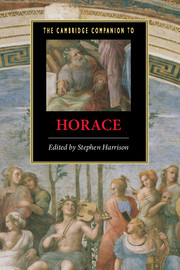9 - The Epistles
from Part 2: - Poetic Genres
Published online by Cambridge University Press: 28 May 2007
Summary
Our manuscripts of Horace and his ancient commentators know two different books of epistulae in the corpus of his poems. What is thus called the 'first book of Epistles' (epistularum liber primus) in the manuscripts is a collection of 20 hexameter poems of varying length, from 13 to 112 lines, which were published by Horace in the year 20 or 19 bce, and probably composed during the three or four preceding years. A second 'book of epistles' comprises two much longer poems addressing Iulius Florus and Augustus, and devoted mainly to literary topics (though the letter to Florus, the older of the two, is still very close to the first book). These later poems, to which the longer Ars Poetica, or Ad Pisones (AP), is sometimes attached as 'Epistle 2.3', are less clearly identifiable as letters, and they altogether belong in a tradition different from that of the first Book. The two 'books' therefore call for separate discussions, and we shall concentrate first on Book 1.
The practice of presenting a poem as a letter in verse, rather than as a song performed before an audience at a symposium or a religious celebration, is early, and cross-generic, spanning from lyric to elegy: it has been recognised in Sappho and Solon (to Mimnermus), and even some among the epinicia of Pindar and Bacchylides are commonly treated as poetic epistles.
In the Hellenistic age an important change has occurred, because poems are often referred to as written documents, physical objects which can be addressed and delivered to someone. In this context, it must have been relatively natural, even for texts not exhibiting formal markers of epistolarity, such as initial and final salutations, to become in some sense epistolary. However, among extant poems of this age, texts explicitly presented as sent messages are few, mainly some epigrams accompanying gifts, invitation billets (AP 11.44), and love letters (AP 5.9).
- Type
- Chapter
- Information
- The Cambridge Companion to Horace , pp. 121 - 131Publisher: Cambridge University PressPrint publication year: 2007
- 3
- Cited by

